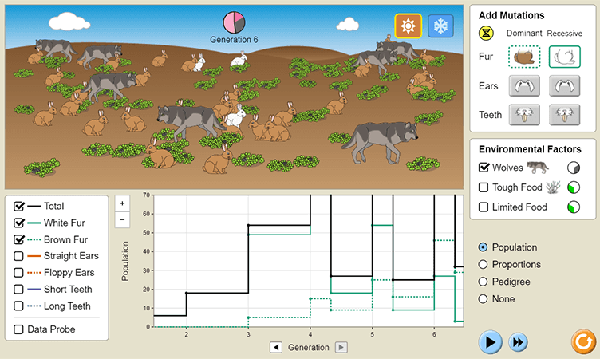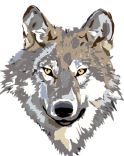Natural Selection Simulation at Phet 
Website http://phet.colorado.edu/en/simulation/natural-selection

1. When you first open the simulation, one bunny will be shown on your screen. The simulation allows you to control types of mutations that occur in the bunnies. Look for the area that says “add mutations.”
What mutations can you add to your bunny?
2. There are three environmental factors listed that can also be changed. What are they?
Click “add a mate.” What happens?
***Click on the RESET button and you will get another bunny and the screen will return to its original.
3. In the top right corner of the screen is a sun and a snowflake. What happens when you click on the snowflake?
4. In nature, populations don’t get out of control because there are limiting factors in the environment. Start your simulation over and click “limited food.” and then “add a mate.” Run the simulation for 12 generations. Click “zoom out” on the graph to see the bunny numbers.
Describe what happens to the bunnies when food is limited.
Sketch the graph shown of the bunnies for 6-10 generations. (You can pause the simulation.)
5. Animals have adaptations that can help them survive in their environment. Reset the simulation and click on the button for dominant long teeth. Note this will add a mutation for bunnies to have longer teeth.

Click on “limited food” for an environmental factor. Add a mate.
Run the simulation for 12 generations. Note that the graph now has three lines, one for short and one for long teeth, and one for total. Click off the “total” to more clearly see the factors and zoom out.
Describe what happens over 12 generations to the number of bunnies with short and long teeth.
Suggest a reason for why there are more bunnies with short teeth than long teeth when food is limited.
6. Reset the simulation. Bunnies can have brown or white fur. Click the button for dominant brown fur mutation. Let the bunnies populate for 2 generations then click to Wolves as an environmental factor. (Don’t forget to add a mate)

Describe what happens over 12 generations to the number of bunnies with brown and white fur.
Suggest a reason for why there are more bunnies with brown fur.
7. Reset the simulation. Click the button for a dominant brown fur mutation. Let the bunnies populate for 2 generations. This time, instead of wolves, limit the food as an environmental factor. Describe what happens over 12 generations to the number of bunnies with brown and white fur with limite food as a selection factor.
Suggest a reason for why limiting food (instead of wolves) changes the outcome.
8. Reset the simulation. Add wolves as an environmental factor and a brown fur mutation. This time, click the corner button to change the environment to “snowflake.” Add wolves. Explain why there are more white bunnies than brown in this environment.

9. Conduct an experiment to determine what environment or environmental factors favor “long teeth.” In what environment(s) did the long teeth provide an advantage for the bunnies.
10. Complete the VIDA Chart - focusing on the bunnies in the simulation
Condition |
Description |
Evidence from Species Studied |
Variation |
Individuals in a population differ in some trait. Variations can be physical features, behaviors, bodily functions, or resistance to disease. |
|
Inheritance |
The trait is inherited (passed from |
|
Differential Survival and Reproduction |
Some individuals with a trait are more likely to survive and reproduce than those without the trait. Selection depends on the environment. Traits that are beneficial in one environment may not be beneficial in another. |
|
Adaptation |
The frequency of the trait that helps individuals survive or leave more offspring will increase in the population over time. |
Other Resources on Evolution
Peppered Moth Simulation - updated simulation on the peppered moth
Stickleback Fish - This HHMI virtual lab requires students to count the phenotypes of stickleback fish in two distinct lakes
Evolution of Bunnies - examine a set of four graphics showing change over time. Great opener for evolution and introduction to VIDA charts.
African Elephant: Change Over Time - examine a graph showing the number of elephants with tusks, showing that the number has changed as a result of poaching
VIDA Chart for Evolution - can be used with any model organism to organize concepts: variation, inheritance, differential survival, and adaptation

